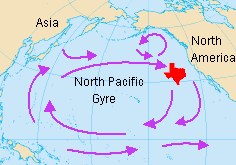by Larry
June, 2004Texas-Size It! - Super Rafts of Floating PlasticMost folks are aware that Texans are often proud of just about all things Texan and that, where we come from, size matters! Up till Alaska had the gall to become our 49th state, Texas held the record for being the biggest and best such governmental unit in our great nation. To this day, Texas, larger than several other states combined, is synonymous with the idea of spaciousness. The fact is, Texas is an enormous piece of real estate. So it is particularly noteworthy that now in the supposed emptiness of the oceans there are vast floating islands of refuse, the largest of which studied so far, in a region west of California and northeast of Hawaii, so great that it is described as a thousand miles across and as big in area as Texas.
Into these low circulation spaces decades' worth of our garbage collects into enormous rafts made up mainly of plastic. Along the way they pick up and harbor as well a myriad of the world's floating throw-aways, everything from drums of hazardous chemicals to volleyballs, plastic coat hangers, light bulbs, fishing floats, nets, bleach bottles, footwear, cathode-ray TV tubes, truck tires (complete with the wheel rims), etc. So extensive is this floating garbage island phenomenon in the gyres of the world's oceans that it is estimated a fourth of the planet's surface is now accumulating such perpetual plastic mats. Because the material in these blights is not truly biodegradable but simply, over time, breaks apart into smaller and smaller but still molecularly integrated parts of itself, and there is more garbage being produced and released into the seas than can be dispersed and degraded, such areas will tend to become more and more densely and widely packed with our buoyant artifacts. A sinister peculiarity of the partially broken up or "biodegraded" plastic is that it concentrates toxins from the surrounding water till they are up to a million times or more their usual chemical levels in the open ocean. These small bits of lure-like baubles, still floating at or near the surface, attract birds, fish and smaller fauna. They are indigestible, though, and cause death either because they overwhelm the systems and metabolisms of the creatures that feed on them or due to their intense "poison pill" properties. Still hazardous down to the smallest particles, they have been found inside creatures as diverse as jellyfish, transparent filter feeders, albatrosses, pelagic fish, sea turtles, and so forth. We humans, in turn, are catching and eating fish that have ingested either plastic filled with harmful toxins or numerous smaller animals that had eaten tiny pieces of toxin-filled plastic. Nobody knows the ultimate effects of such toxins spreading up and down the oceanic food chain or, indeed, of the vast mats of plastic covering greater and greater swaths of ocean surface. The petroleum products from which today's plastic trash was made derived in part from eons of births and deaths of the primordial plankton. It is as if, like huge schools of migratory creatures, the pieces of plastic are returning to their home waters though, as with so many invertebrate sea organisms, in rather different form at the end of their life cycles.
Source: Trashed. Charles Moore in Natural History Magazine, Vol. 112, pp. 46-51; November, 2003. |
 It turns out that the ocean currents swirl about the globe in circular motions that, while quite dynamic in places, often leave relatively stable "subtropical gyres" where colossal high-pressure systems keep the winds calm and the surface of the sea relatively smooth.
It turns out that the ocean currents swirl about the globe in circular motions that, while quite dynamic in places, often leave relatively stable "subtropical gyres" where colossal high-pressure systems keep the winds calm and the surface of the sea relatively smooth.